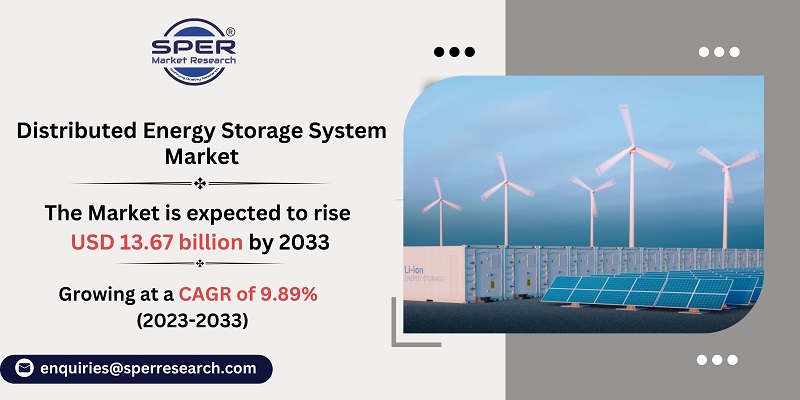
Distributed Energy Storage System Market Growth, Size, Trends, Share, Revenue and Future Scope
Distributed Energy Storage System Market Size- By Capacity Type, By Battery, By Application, By End User- Regional Outlook, Competitive Strategies and Segment Forecast to 2033
| Published: Nov-2023 | Report ID: POAE2374 | Pages: 1 - 216 | Formats*: |
| Category : Power & Energy | |||
- ABB and US technology firm Humless worked together to develop a solar-managed home energy storage system (ESS). The 48 V Universal Energy Management (UEM) system from Humless and the UNO-DM-TL-PLUS range of household inverters from ABB are combined to create the Universal 10/4 household Storage System.
- Schneider Electric introduced EcoStruxure DERMS in November 2019. It offers centralized management and analysis of all DER kinds, irrespective of their ownership structure, to benefit the grid and all parties involved in the energy industry.


| Report Metric | Details |
| Market size available for years | 2019-2033 |
| Base year considered | 2022 |
| Forecast period | 2023-2033 |
| Segments covered | By Capacity Type, By Battery, By Application, By End User |
| Regions covered | North America, Asia-Pacific, Latin America, Middle East & Africa and Europe |
| Companies Covered | ABB Ltd, Advanced Control Systems, LLC, Hitachi, Ltd, Johnson Controls International Plc, LG Energy Solution Ltd, NEC Corporation, The General Electric Company, Jabil Inc, Others. |
- Energy Utilities
- Renewable Energy Developers
- Industrial and Commercial Businesses
- Residential Consumers
- Government and Regulatory Bodies
- Energy Storage Manufacturers
- Investors and Financial Institutions
- Research and Development Organizations
- Grid Operators and System Operators
| By Capacity Type: |
|
| By Battery: |
|
| By Application: |
|
| By End User: |
|
- Global Distributed Energy Storage System Market Size (FY’2023-FY’2033)
- Overview of Global Distributed Energy Storage System Market
- Segmentation of Global Distributed Energy Storage System Market By Capacity Type (Single-phase Type, Three-Phase Type, Double-phase Fire Line Type)
- Segmentation of Global Distributed Energy Storage System Market By Battery (Nickel-Cadmium, Lead Acid, Lithium-Ion, Others)
- Segmentation of Global Distributed Energy Storage System Market By Application (Transportation, Grid Storage, Renewable Energy Storage, Others)
- Segmentation of Global Distributed Energy Storage System Market By End User (Commercial, Residential)
- Statistical Snap of Global Distributed Energy Storage System Market
- Expansion Analysis of Global Distributed Energy Storage System Market
- Problems and Obstacles in Global Distributed Energy Storage System Market
- Competitive Landscape in the Global Distributed Energy Storage System Market
- Impact of COVID-19 and Demonetization on Global Distributed Energy Storage System Market
- Details on Current Investment in Global Distributed Energy Storage System Market
- Competitive Analysis of Global Distributed Energy Storage System Market
- Prominent Players in the Global Distributed Energy Storage System Market
- SWOT Analysis of Global Distributed Energy Storage System Market
- Global Distributed Energy Storage System Market Future Outlook and Projections (FY’2023-FY’2033)
- Recommendations from Analyst
1.1. Scope of the report1.2. Market segment analysis
2.1. Research data source2.1.1. Secondary Data2.1.2. Primary Data2.1.3. SPER’s internal database2.1.4. Premium insight from KOL’s2.2. Market size estimation2.2.1. Top-down and Bottom-up approach2.3. Data triangulation
4.1. Driver, Restraint, Opportunity and Challenges analysis4.1.1. Drivers4.1.2. Restraints4.1.3. Opportunities4.1.4. Challenges4.2. COVID-19 Impacts of the Global Distributed Energy Storage System Market
5.1. SWOT Analysis5.1.1. Strengths5.1.2. Weaknesses5.1.3. Opportunities5.1.4. Threats5.2. PESTEL Analysis5.2.1. Political Landscape5.2.2. Economic Landscape5.2.3. Social Landscape5.2.4. Technological Landscape5.2.5. Environmental Landscape5.2.6. Legal Landscape5.3. PORTER’s Five Forces5.3.1. Bargaining power of suppliers5.3.2. Bargaining power of buyers5.3.3. Threat of Substitute5.3.4. Threat of new entrant5.3.5. Competitive rivalry5.4. Heat Map Analysis
6.1. Global Distributed Energy Storage System Market Manufacturing Base Distribution, Sales Area, Product Type6.2. Mergers & Acquisitions, Partnerships, Product Launch, and Collaboration in Global Distributed Energy Storage System Market
7.1. Global Distributed Energy Storage System Market Value Share and Forecast, By Capacity Type, 2023-20337.2. Single-phase Type7.3. Three-Phase Type7.4. Double-phase Fire Line Type
8.1. Global Distributed Energy Storage System Market Value Share and Forecast, By Battery, 2023-20338.2. Nickel-Cadmium8.3. Lead Acid8.4. Lithium-Ion8.5. Others
9.1. Global Distributed Energy Storage System Market Value Share and Forecast, By Application, 2023-20339.2. Transportation9.3. Grid Storage9.4. Renewable Energy Storage9.5. Others
10.1. Global Distributed Energy Storage System Market Value Share and Forecast, By End User, 2023-203310.2. Commercial10.3. Residential
11.1. Global Distributed Energy Storage System Market Size and Market Share
12.1. Global Distributed Energy Storage System Market Size and Market Share By Capacity Type (2019-2026)12.2. Global Distributed Energy Storage System Market Size and Market Share By Capacity Type (2027-2033)
13.1. Global Distributed Energy Storage System Market Size and Market Share By Battery (2019-2026)13.2. Global Distributed Energy Storage System Market Size and Market Share By Battery (2027-2033)
14.1. Global Distributed Energy Storage System Market Size and Market Share By Application (2019-2026)14.2. Global Distributed Energy Storage System Market Size and Market Share By Application (2027-2033)
15.1. Global Distributed Energy Storage System Market Size and Market Share By End Use (2019-2026)15.2. Global Distributed Energy Storage System Market Size and Market Share By End Use (2027-2033)
16.1. Global Distributed Energy Storage System Market Size and Market Share By Region (2019-2026)16.2. Global Distributed Energy Storage System Market Size and Market Share By Region (2027-2033)16.3. Asia-Pacific16.3.1. Australia16.3.2. China16.3.3. India16.3.4. Japan16.3.5. South Korea16.3.6. Rest of Asia-Pacific16.4. Europe16.4.1. France16.4.2. Germany16.4.3. Italy16.4.4. Spain16.4.5. United Kingdom16.4.6. Rest of Europe16.5. Middle East and Africa16.5.1. Kingdom of Saudi Arabia16.5.2. United Arab Emirates16.5.3. Rest of Middle East & Africa16.6. North America16.6.1. Canada16.6.2. Mexico16.6.3. United States16.7. Latin America16.7.1. Argentina16.7.2. Brazil16.7.3. Rest of Latin America
17.1. ABB Ltd.17.1.1. Company details17.1.2. Financial outlook17.1.3. Product summary17.1.4. Recent developments17.2. Advanced Control Systems, LLC17.2.1. Company details17.2.2. Financial outlook17.2.3. Product summary17.2.4. Recent developments17.3. Hitachi, Ltd.17.3.1. Company details17.3.2. Financial outlook17.3.3. Product summary17.3.4. Recent developments17.4. Johnson Controls International Plc.17.4.1. Company details17.4.2. Financial outlook17.4.3. Product summary17.4.4. Recent developments17.5. LG Energy Solution Ltd.17.5.1. Company details17.5.2. Financial outlook17.5.3. Product summary17.5.4. Recent developments17.6. NEC Corporation17.6.1. Company details17.6.2. Financial outlook17.6.3. Product summary17.6.4. Recent developments17.7. The General Electric Company17.7.1. Company details17.7.2. Financial outlook17.7.3. Product summary17.7.4. Recent developments17.8. Jabil Inc.17.8.1. Company details17.8.2. Financial outlook17.8.3. Product summary17.8.4. Recent developments17.9. Others
SPER Market Research’s methodology uses great emphasis on primary research to ensure that the market intelligence insights are up to date, reliable and accurate. Primary interviews are done with players involved in each phase of a supply chain to analyze the market forecasting. The secondary research method is used to help you fully understand how the future markets and the spending patterns look likes.
The report is based on in-depth qualitative and quantitative analysis of the Product Market. The quantitative analysis involves the application of various projection and sampling techniques. The qualitative analysis involves primary interviews, surveys, and vendor briefings. The data gathered as a result of these processes are validated through experts opinion. Our research methodology entails an ideal mixture of primary and secondary initiatives.



Frequently Asked Questions About This Report
PLACE AN ORDER
Year End Discount
Sample Report
Pre-Purchase Inquiry
NEED CUSTOMIZATION?
Request CustomizationCALL OR EMAIL US
100% Secure Payment






Related Reports
Our Global Clients
Our data-driven insights have influenced the strategy of 200+ reputed companies across the globe.




















